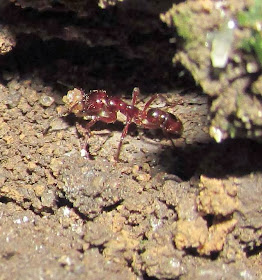Microcerotermes sp(04) is differentiate from the rest of this genus which are mostly arboreal, in that it nest in decaying wood on the forest floor, which could explain the tube shape head capsule narrow circular cross section keeping subterranean tunnels narrow as protection from predators.
The soldiers of this species has the most tubular head of all the species documented so far in this blog.
Unlike many species of this genus which build corridors up and down the trees (and also other man made structures) from their arboreal nests.
Other Species:
Taxonomy:
Cellular organisms; 131567
Eukaryota; 2759
Opisthokonta; 33154
Metazoa; 33208
Eumetazoa; 6072
Bilateria; 33213
Coelomata; 33316
Protostomia; 33317
Panarthropoda; 88770
Arthropoda; 6656
Mandibulata; 197563
Pancrustacea; 197562
Hexapoda; 6960
Insecta; 50557
Dicondylia; 85512
Pterygota; 7496
Neoptera; 33340
Orthopteroidea; 33341
Dictyoptera; 6970
Blattodea 85823
Isoptera; 7499
Termitidae; 46569
Termitinae; 92738
Amitermes group; 377832
Microcerotermes; 139992
Last Updated: 2020 06 24
First Posted: 2019 09 10
© 2011 – 2020 Quah. All rights reserved.

















































